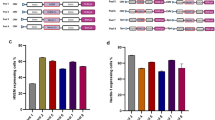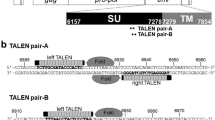Abstract
Preclinical studies using various cell culture and animal systems highlight the potential of recombinant rodent parvoviruses (recPVs) for cancer therapy. Production of these viruses is, however, not efficient and this hampers the clinical applications of these agents. In this study, we show that the adenovirus genes E2a, E4(orf6) and VA RNA increase the production of recPVs by more than 10-fold and reduce the time of production from 3 to 2 days in HEK293T cells. The helper effects of these genes can be observed with different recPVs, regardless of the nature and size of the inserted transgene. Furthermore, we generated a recombinant Adenovirus 5 carrying the parvovirus VP transcription unit. This helper, named Ad-VP, allows recPVs to be efficiently produced through a protocol based only on cell infection, making possible to use cell lines, such as NB324K, which are good producers of parvoviruses but are hardly transfectable. Hence, we could further improve viral titers and reduce time and costs of production. This Ad-VP helper-based protocol could be scaled up to a bioreactor format for the generation of the large amounts of recPVs needed for future clinical applications.
This is a preview of subscription content, access via your institution
Access options
Subscribe to this journal
Receive 12 print issues and online access
$259.00 per year
only $21.58 per issue
Buy this article
- Purchase on Springer Link
- Instant access to full article PDF
Prices may be subject to local taxes which are calculated during checkout






Similar content being viewed by others
References
Rommelaere J, Cornelis JJ . Antineoplastic activity of parvoviruses. J Virol Methods 1991; 33: 233–251.
Atchison RW, Casto BC, Hammon WM . Adenovirus-associated defective virus particles. Science 1965; 149: 754–756.
Cornelis JJ, Deleu L, Kock U, Rommelaere J . Parvovirus oncosuppression. In: Kerr JR, Bloom ME, Linden RM, Parrish CR (eds). Parvoviruses. Hodder Arnold E Ltd, London: United Kingdom, London, 2006, pp 365–378.
Kestler J, Neeb B, Struyf S, Van Damme J, Cotmore SF, D’Abramo A et al. cis requirements for the efficient production of recombinant DNA vectors based on autonomous parvoviruses. Hum Gene Ther 1999; 10: 1619–1632.
Cornelis JJ, Salome N, Dinsart C, Rommelaere J . Vectors based on autonomous parvoviruses: novel tools to treat cancer? J Gene Med 2004; 6 (Suppl 1): S193–S202.
Dupont F, Avalosse B, Karim A, Mine N, Bosseler M, Maron A et al. Tumor-selective gene transduction and cell killing with an oncotropic autonomous parvovirus-based vector. Gene Ther 2000; 7: 790–796.
Olijslagers S, Dege AY, Dinsart C, Voorhoeve M, Rommelaere J, Noteborn MH et al. Potentiation of a recombinant oncolytic parvovirus by expression of Apoptin. Cancer Gene Ther 2001; 8: 958–965.
El Bakkouri K, Servais C, Clement N, Cheong SC, Franssen JD, Velu T et al. In vivo anti-tumour activity of recombinant MVM parvoviral vectors carrying the human interleukin-2 cDNA. J Gene Med 2005; 7: 189–197.
Haag A, Menten P, Van Damme J, Dinsart C, Rommelaere J, Cornelis JJ . Highly efficient transduction and expression of cytokine genes in human tumor cells by means of autonomous parvovirus vectors; generation of antitumor responses in recipient mice. Hum Gene Ther 2000; 11: 597–609.
Wetzel K, Menten P, Opdenakker G, Van Damme J, Grone HJ, Giese N et al. Transduction of human MCP-3 by a parvoviral vector induces leukocyte infiltration and reduces growth of human cervical carcinoma cell xenografts. J Gene Med 2001; 3: 326–337.
Wetzel K, Struyf S, Van Damme J, Kayser T, Vecchi A, Sozzani S et al. MCP-3 (CCL7) delivered by parvovirus MVMp reduces tumorigenicity of mouse melanoma cells through activation of T lymphocytes and NK cells. Int J Cancer 2007; 120: 1364–1371.
Giese NA, Raykov Z, DeMartino L, Vecchi A, Sozzani S, Dinsart C et al. Suppression of metastatic hemangiosarcoma by a parvovirus MVMp vector transducing the IP-10 chemokine into immunocompetent mice. Cancer Gene Ther 2002; 9: 432–442.
Enderlin M, Kleinmann EV, Struyf S, Buracchi C, Vecchi A, Kinscherf R et al. TNF-alpha and the IFN-gamma-inducible protein 10 (IP-10/CXCL-10) delivered by parvoviral vectors act in synergy to induce antitumor effects in mouse glioblastoma. Cancer Gene Ther 2009; 16: 149–160.
Brandenburger A, Russell S . A novel packaging system for the generation of helper-free oncolytic MVM vector stocks. Gene Ther 1996; 3: 927–931.
El Bakkouri K, Clement N, Velu T, Brandenburger A . Amplification of MVM(p) vectors through serial infection of a new packaging cell line. Tumor Targeting 1999; 4: 210–217.
Chang LS, Shi Y, Shenk T . Adeno-associated virus P5 promoter contains an adenovirus E1A-inducible element and a binding site for the major late transcription factor. J Virol 1989; 63: 3479–3488.
Carter BJ, Antoni BA, Klessig DF . Adenovirus containing a deletion of the early region 2A gene allows growth of adeno-associated virus with decreased efficiency. Virology 1992; 191: 473–476.
Janik JE, Huston MM, Cho K, Rose JA . Efficient synthesis of adeno-associated virus structural proteins requires both adenovirus DNA binding protein and VA I RNA. Virology 1989; 168: 320–329.
Fisher KJ, Gao GP, Weitzman MD, DeMatteo R, Burda JF, Wilson JM . Transduction with recombinant adeno-associated virus for gene therapy is limited by leading-strand synthesis. J Virol 1996; 70: 520–532.
Nayak R, Pintel DJ . Adeno-associated viruses can induce phosphorylation of eIF2alpha via PKR activation, which can be overcome by helper adenovirus type 5 virus-associated RNA. J Virol 2007; 81: 11908–11916.
Grimm D, Kleinschmidt JA . Progress in adeno-associated virus type 2 vector production: promises and prospects for clinical use. Hum Gene Ther 1999; 10: 2445–2450.
Xiao X, Li J, Samulski RJ . Production of high-titer recombinant adeno-associated virus vectors in the absence of helper adenovirus. J Virol 1998; 72: 2224–2232.
Matsushita T, Elliger S, Elliger C, Podsakoff G, Villarreal L, Kurtzman GJ et al. Adeno-associated virus vectors can be efficiently produced without helper virus. Gene Ther 1998; 5: 938–945.
Grimm D, Kern A, Rittner K, Kleinschmidt JA . Novel tools for production and purification of recombinant adenoassociated virus vectors. Hum Gene Ther 1998; 9: 2745–2760.
Guan W, Wong S, Zhi N, Qiu J . The genome of human parvovirus B19 can replicate in nonpermissive cells with the help of adenovirus genes and produces infectious virus. J Virol 2009; 83: 9541–9553.
Ledinko N, Toolan HW . Human adenovirus type 12 as a ‘helper’ for growth of H-1 virus. J Virol 1968; 2: 155–156.
Fox E, Moen Jr PT, Bodnar JW . Replication of minute virus of mice DNA in adenovirus-infected or adenovirus-transformed cells. Virology 1990; 176: 403–412.
Wrzesinski C, Tesfay L, Salome N, Jauniaux JC, Rommelaere J, Cornelis J et al. Chimeric and pseudotyped parvoviruses minimize the contamination of recombinant stocks with replication-competent viruses and identify a DNA sequence that restricts parvovirus H-1 in mouse cells. J Virol 2003; 77: 3851–3858.
Mailly L, Boulade-Ladame C, Orfanoudakis G, Deryckere F . A novel adenovirus vector for easy cloning in the E3 region downstream of the CMV promoter. Virol J 2008; 5: 73.
He TC, Zhou S, da Costa LT, Yu J, Kinzler KW, Vogelstein B . A simplified system for generating recombinant adenoviruses. Proc Natl Acad Sci USA 1998; 95: 2509–2514.
Reed SE, Staley EM, Mayginnes JP, Pintel DJ, Tullis GE . Transfection of mammalian cells using linear polyethylenimine is a simple and effective means of producing recombinant adeno-associated virus vectors. J Virol Methods 2006; 138 (1–2): 85–98.
Bodendorf U, Cziepluch C, Jauniaux JC, Rommelaere J, Salome N . Nuclear export factor CRM1 interacts with nonstructural proteins NS2 from parvovirus minute virus of mice. J Virol 1999; 73: 7769–7779.
Palmer GA, Tattersall P . Autonomous parvoviruses as gene transfer vehicles. Contrib Microbiol 2000; 4: 178–202.
Lusky M, Grave L, Dieterle A, Dreyer D, Christ M, Ziller C et al. Regulation of adenovirus-mediated transgene expression by the viral E4 gene products: requirement for E4 ORF3. J Virol 1999; 73: 8308–8319.
Acknowledgements
We thank the team of the DKFZ virus production and development unit, in particular Markus Müller, Silvia Münstermann and Barbara Liebertrau for their valuable help with virus production and characterization. We are also indebted to Melanie Krämer for technical assistance and Nathalie Salomé and Michele Vogel for the anti-NS1 antibody. NEA was supported by long-term fellowships from Alexander von Humboldt-Foundation, (Bonn, Germany) and the European Molecular Biology Organization (Heidelberg, Germany). This work was supported by a grant from the Helmholtz-Gemeinschaft in the frame of the Deutsches Krebsforschungszentrum/Cancéropôle du Grand-Est joint Programme in Applied Tumor Virology.
Author information
Authors and Affiliations
Corresponding author
Ethics declarations
Competing interests
A patent application, based on the results described in this article, has been submitted by the authors to the European Patent Office.
Additional information
Supplementary Information accompanies the paper on Cancer Gene Therapy website
Supplementary information
Rights and permissions
About this article
Cite this article
El-Andaloussi, N., Endele, M., Leuchs, B. et al. Novel adenovirus-based helper system to support production of recombinant parvovirus. Cancer Gene Ther 18, 240–249 (2011). https://doi.org/10.1038/cgt.2010.73
Received:
Revised:
Accepted:
Published:
Issue Date:
DOI: https://doi.org/10.1038/cgt.2010.73
Keywords
This article is cited by
-
Oncolytic H-1 parvovirus binds to sialic acid on laminins for cell attachment and entry
Nature Communications (2021)



